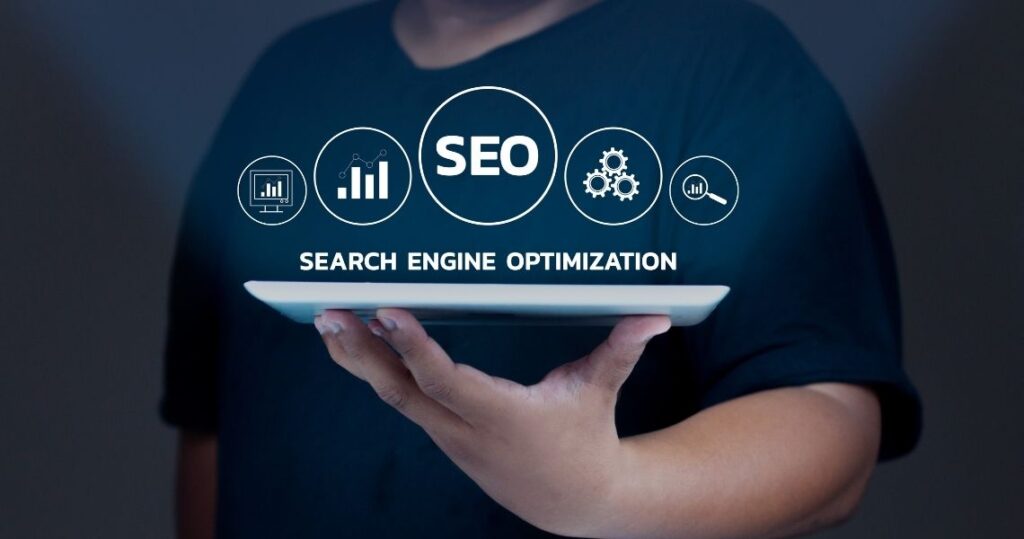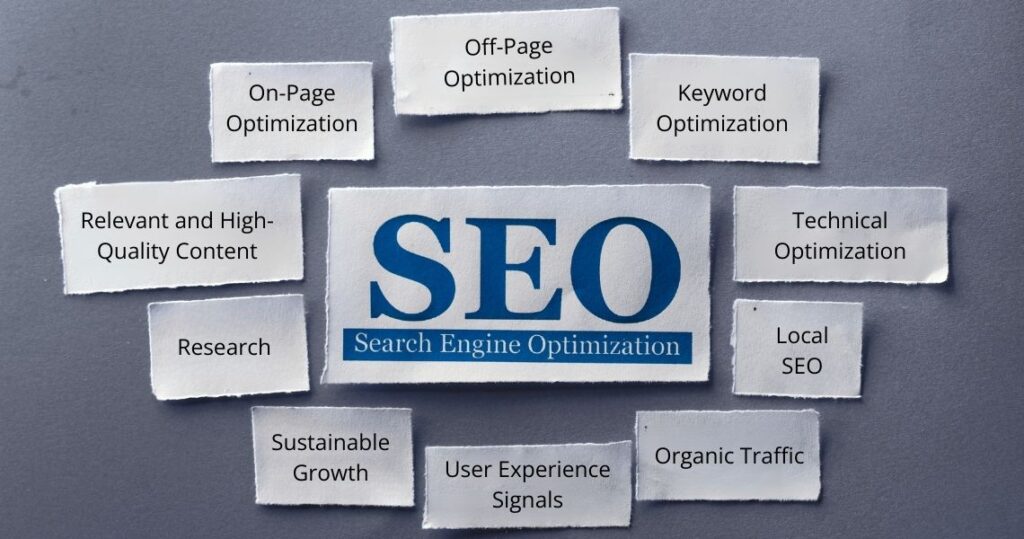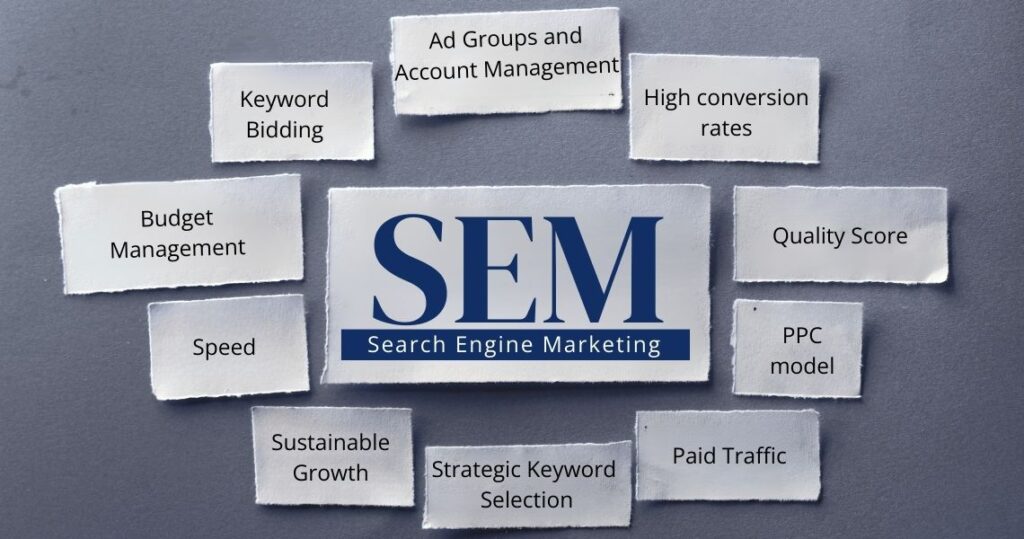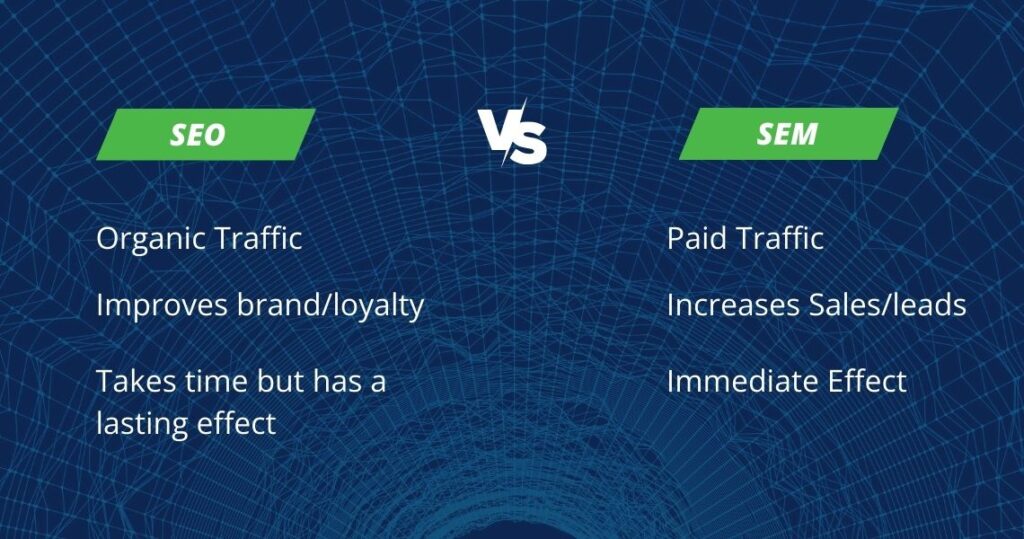Feeling the squeeze of online obscurity? Struggling to attract visitors to your website despite your best efforts? You’re not alone! Navigating the ever-evolving world of digital marketing can be daunting, especially when faced with acronyms like SEO and SEM. They’re often touted as solutions, but the difference between them leaves many confused.
68% of online experiences begin with a search engine. (BrightEdge, 2023) Search Engine Optimization (SEO) and Search Engine Marketing (SEM) are two words often uttered while promising the holy grail of online visibility. While both play a crucial role in propelling your website to the forefront, their approaches differ like yin and yang. In such a scenario, while both strategies are powerful, understanding their distinct natures is key to unlocking your website’s true potential.
Ready to trade frustration for results? This blog is your roadmap to clarity. Let’s understand the distinct roles of SEO and SEM, equipping you with the knowledge and strategies to achieve sustainable digital success for your brand.
What is SEO?

In the simplest words, Search Engine Optimization (SEO) is your key to unlocking organic traffic, and attracting visitors through search engines like Google and Bing without paying for it.
You can think of SEO as strategic content and technical finesse working together to make your website the gem that search engines prioritize.
But how does SEO work? Search engines have complex algorithms that prioritize relevant, high-quality content. SEO involves playing by these rules, crafting content aligned with user intent and technical best practices. For instance, imagine searching for “best hiking boots.” An SEO-optimized website might have blog posts reviewing different boots, detailed product descriptions, and fast loading speeds, signaling to search engines its relevance and user-friendliness. SEO isn’t instant gratification but the rewards are substantial: organic traffic is often more engaged and loyal, translating to higher conversion rates and sustainable growth.
Key Features of SEO:

Here are the key SEO components that are behind mastering the organic approach. A consistent optimization using these key features empowers you to transform your website into a flourishing digital success.
On-Page Optimization:
On-page optimization refines the presentation of your content, ensuring both search engines and users can effortlessly navigate your website. On-page SEO strategically sprinkles keywords into titles, descriptions, and URLs – and guides search engines to your website just like following a partner’s lead in a dance. Optimize structure, and alt text – every step matters. This helps you build trust, climb rankings, and attract your perfect audience naturally.
Off-Page Optimization:
While high-quality backlinks remain the cornerstone of off-page SEO, their influence extends beyond mere linking. In Google’s eyes, backlinks serve as votes of confidence, signifying trust and expertise in your website’s content. E-E-A-T (Expertise, Experience, Authoritativeness, and Trustworthiness) plays a crucial role in Google’s evaluation. Demonstrating expertise through your content, showcasing experience through years of operation, and establishing authoritativeness with awards or industry recognition all contribute to an off-page SEO tapestry that paints a picture of a reliable and trustworthy website.
Furthermore, social media engagement can subtly influence your off-page SEO standing. Shares, likes, and positive comments act as a form of social proof, indicating that your content resonates with users and sparks online conversations.
Technical Optimization:
Technical Optimization acts as the architect of the SEO business, ensuring search engines can effortlessly navigate this library, unlocking each page of valuable information for users to discover. It’s not just about visibility, but accessibility. It focuses on optimizing site structure and page speed by clearing pathways and removing clutter, allowing search engines to crawl and index your content efficiently.
Local SEO:
Local SEO unlocks the classic gem of location-based searches. Imagine your website not just existing online, but thriving within your local community. By optimizing for “best pizza near me” or “reliable broker near me,” you position yourself as the answer on search engines’ virtual map. Nearly half of the searches today have a local intent, highlighting the vast potential waiting to be tapped. With local SEO, you can go beyond general visibility and attract customers right next door!
Keyword Optimization:
Keyword research forms the foundation of effective SEO. By investigating relevant search terms and incorporating them seamlessly into your content, you’ll guide users directly to your website or webpage. Keyword research tools paint a detailed picture of search volume, competition, and related keywords. Understanding these metrics allows you to strategically target terms with high potential yet manageable competition. The true power of keyword research lies in its symbiotic relationship with content creation. By weaving relevant keywords seamlessly into your content, you create a bridge between your audience’s search queries and the valuable information you offer.
Relevant and Quality Content:
High-quality, user-centric content transcends mere information, becoming a trusted advisor and a companion to their digital experience. Craft informative and engaging pieces that resonate with your target audience, establishing your website as a trusted source of valuable information.
Exceptional content attracts loyal visitors and signals authority to search engines, boosting your rankings. This content doesn’t exist in a vacuum; it engages in a silent dialogue with search engines, its quality, and engagement whispering tales of authority and relevance, ultimately propelling your website to the forefront of search results.
User Experience Signals:
Prioritizing User Experience (UX) is crucial for retaining visitors and fostering engagement. You have to ensure that your website boasts lightning-fast loading speeds, seamless mobile responsiveness, and intuitive navigation. By providing a smooth and enjoyable user journey, you’ll convert casual explorers into frequent visitors.
How people interact with your site affects where it shows up in search results. If people quickly leave your page (high bounce rate), it tells Google the page might not be relevant to the search. This could lower your ranking, potentially dropping you off the first page entirely. To avoid this, create content that answers users’ queries and keeps them engaged, showing Google your page is a good fit for the search.
What is SEM?

Search Engine Marketing (SEM), encompasses paid advertising methods like Pay-Per-Click (PPC) ads to increase a website’s prominence in search results. These paid ads occupy highly visible locations on search engine result pages (SERPs), often appearing at the top, side, or bottom. This allows businesses to target specific keywords and reach users actively searching for relevant products or services.
Unlike the organic climb fueled by content optimization and technical prowess, SEM involves direct payment for ad placement. This approach offers immediate visibility, bypassing the often lengthy path of organic ranking improvement. It’s also important to note that SEM effectiveness hinges on strategic keyword selection, ad copy optimization, and campaign budgeting. While offering quicker results compared to SEO, it requires ongoing investment and management to ensure cost-effectiveness and optimal return on ad spend.
Key Features of SEM:

SEM thrusts you into the fast-paced world of paid search advertising. Here’s your guide to navigating the key features of SEM:
Keyword Bidding:
Each keyword you target is a bidding war. The higher you bid, the higher your ad ranks in search results (usually). Your winning bid translates to your cost per click (CPC), the amount you pay each time someone clicks your ad. So, strategize wisely! Bid high for coveted keywords, but keep an eye on your budget and Quality Score to ensure every click brings valuable leads, not just inflated expenses.
Quality Score:
Quality Score acts like the Google seal of approval. Google rewards relevant ads with a high-Quality Score, translating to lower CPCs. Factors like click-through rate (CTR), landing page quality, and account history affect your score. You can think of Quality Score as your ad’s GPA – study hard, get rewarded!
Ad Copy:
Ad Copy should consist of words that convert. Your ad copy is the first impression, the hook that entices users to click. Compelling language, clear calls to action, and keyword relevance are crucial. Weak copy leads to poor CTRs, tanking your Quality Score and inflating costs.
Ad Groups & Account Management:
This tool refers to data-driven optimization. You wouldn’t want to just throw bids around blindly. With Ad Groups and Account Management, you analyze data within your Google Ads account to optimize your Ad campaigns. Group related keywords, monitor performance and adjust bids strategically.
Budget Management:
Effective budget allocation acts as the cornerstone of successful SEM campaigns. Allocate your resources wisely, targeting high-potential keywords while keeping an eye on cost-effectiveness. Monitor campaign performance, adjust bids strategically, and leverage Quality Score to maximize your return on investment (ROI). You have to ensure that every click should be a calculated step towards your marketing goals, and not an impulsive splurge.
SEO vs SEM

Search Engine Optimization (SEO) and Search Engine Marketing (SEM) promise increased website visibility, but which path should you choose?
In this section, we’ll look at the key differences between SEO and SEM, explore their unique approaches, and uncover their strengths and limitations to help you make informed decisions for your digital presence.
| Factor | SEO | SEM |
|---|---|---|
| Nature of Traffic | Drives organic, unpaid traffic to a website | Drives paid traffic to a website through advertising |
| Marketing Type | Inbound: focuses on your potential customers finding you by searching their interests or pain points | Inbound and Outbound: also pushes your message in front of your potential customers |
| Included Channels | Solely SEO | SEO, PPC, Display, Local & more |
| Cost | Involves upfront costs for optimization but is generally considered a long-term investment | Requires ongoing costs as advertisers pay for each click on their ads |
| Timeline for Results | Takes time to see significant results, as it relies on organic growth and algorithm changes | Provides almost immediate visibility and results, as ads are displayed once the campaign is launched |
| Sustainability | Offers sustainable, long-term benefits as organic rankings improve | Benefits are immediate but cease when the advertising budget is exhausted |
| Authority Building | Builds website authority and credibility over time through high-quality content and backlinks | Does not contribute directly to authority building but provides immediate visibility |
Should I Choose SEO or SEM?
Now that you know what both Search Engine Optimization and Search Engine Marketing comprise, you need to decide which one of the two serves your purpose the best. Or do you need both?
Selecting the right approach – SEO or SEM – hinges on understanding your specific needs. SEO offers organic website growth, building authority over time through content and technical optimization. It’s cost-effective but requires patience. Conversely, SEM delivers faster, almost instant results via paid ads, offering targeted reach almost instantly. However, as you know, it demands ongoing investment and close budget management.
So, analyze your business goals and resources. Need immediate visibility? Paid ads might be the answer. Prioritizing long-term, sustainable growth? Consider the organic path of SEO. Ultimately, the most effective approach combines strategic elements of both, tailored to your unique business objectives.
A third approach, of course, is to use both SEO and SEM.
While running both SEO and SEM can be tempting, take a minute to think if it is possible for you. Consider combining them if:
- You have the resources: Both require expertise and time. If you have a dedicated team or budget to outsource, it’s feasible.
- Speed is essential: SEM offers quick visibility, while SEO builds authority over time. Together, they provide a one-two punch – immediate impact and long-term growth.
- Targeted campaigns demand it: Need to reach a specific audience quickly? Paid ads paired with relevant SEO content can amplify your message.
While the ideal approach to SEO and SEM varies case by case, navigating both simultaneously can quickly become a complex juggling act. Between keyword research, content creation, ad campaign management, and performance analysis, valuable time and resources can easily get stretched thin. That’s where expert help comes in. Whether you decide to use SEO, SEM, or both, partnering with a digital marketing and creative agency can be the game-changer your website needs. With their combined expertise in both SEO and SEM, they can craft a tailored strategy that aligns with your specific goals and budget, maximizing your online visibility and driving impactful results.
The Go-To-Guy! is an experienced, award-winning agency that offers more than just expertise in both SEO and SEM. Our agency is experienced in building brands, crafting impactful campaigns, and driving results. Beyond expertise, The Go-To Guy! brings a personalized approach to the table. We carefully understand your specific goals, budget, and target audience. This tailored approach ensures that your SEO and SEM efforts are laser-focused, delivering maximum impact for your unique online presence. Ready to trade tightrope walking for confident strides toward your digital marketing goals? You don’t have to do it alone – Connect with us today to create a winning roadmap for your website’s visibility and success.

